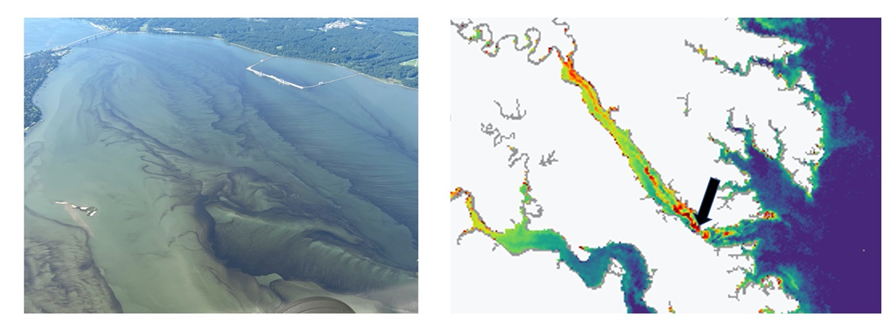NOAA’s National Centers for Coastal Ocean Science (NCCOS) provided a Harmful Algal Bloom (HAB) Event Response award of $6,820 to the Virginia Institute of Marine Science (VIMS) to respond to an intense HAB in the lower Chesapeake Bay, in collaboration with NOAA, Virginia Department of Health, and state shellfish growers. These efforts will also help improve regional HAB monitoring and forecasting capabilities by supporting satellite algorithm validation activities.
In mid-August, the formation of a very intense bloom of the toxin-producing algal species Margalefidinium (previously Cochlodinium) polykrikoides in the York River, VA was confirmed by satellite imagery and aerial photos. Since 2007, blooms of M. polykrikoides have historically been followed by large and extensive blooms of another HAB-forming species, Alexandrium monilatum, throughout the lower Chesapeake Bay. Both species are considered harmful because they have been known to cause adverse effects on juvenile oysters, finfish, and other commercially important seafood. Virginia ranks second in the nation for production of farmed oysters, and first in clam production. Therefore, these intense blooms cause great concern about ecological and economic impacts on valuable aquaculture and fishing industries throughout the Chesapeake Bay because they impact the health and growth of shellfish. However, they do not result in toxic shellfish and there have not been reported human illnesses associated with consumption of Chesapeake Bay shellfish.

VIMS researchers are using this funding to collect water samples and quantify algal cells via FlowCam and quantitative PCR, while NOAA is collecting above-water radiometer measurements for satellite algorithm development for Sentinel-3 satellites and processing bulk chlorophyll levels and algal cell counts via microscopy. Together, these measurements will allow scientists to improve detection methods for individual Chesapeake Bay HAB species; look at changes in their optical signatures throughout the bloom (initiation to demise); and determine cell abundance estimates from space to improve satellite detection.
Additionally, this effort will help NCCOS and its partners expand the current HABscope network to the Chesapeake Bay and develop artificial intelligence to detect A. monilatum in the lower Chesapeake Bay. Water samples will be collected to help train the HABScope system software to recognize and classify the long chains of A. monilatum. Building on experiences in the Gulf of Mexico, efforts are underway to adapt the user-friendly monitoring tool to advance monitoring and forecasting efforts to help mitigate HAB impacts on the lower Chesapeake Bay.
Results from the collaborative response effort are being distributed to regional partners, shellfish growers, and the Virginia Department of Health weekly. Shellfish growers can use this information to make informed decisions in the region, this includes possible changes to cleaning protocols in bloom-exposed areas, relocating shellfish cages, and if possible, shutting off hatchery and nursery intake water when bloom waters approach their facilities. Data from this response effort will also help support the goals of regional regulatory agencies and growers for improved capacity to respond to future blooms
The NCCOS HAB Event Response Program provides immediate assistance to help federal, state, and local officials manage events and advance the understanding of HABs as they occur.
For more information about the Event Response, contact marykate.rogener@noaa.gov, and for more information about the satellite remote sensing images and the HABscope, contact michelle.tomlinson@noaa.gov.
